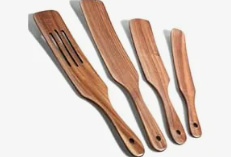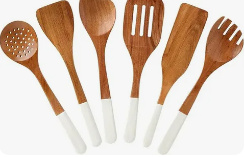It is a must- have tool in every kitchen, offering versatility and ease for a variety of cooking tasks. Whether you’re stirring porridge, mists, or gravies, the unique design of the spurtle ensures that you can cook more efficiently and effectively. This composition will take you through everything you need to know about spurtles, from their history and uses to the different accoutrements available. By the end, you’ll understand why this simple tool should be part of your kitchen rudiments.

What Is a Spurtle?
It is a traditional kitchen tool with a long, narrow handle and a slightly twisted end, generally made from wood, silicone, or other accoutrements . Originating in Scotland, it was traditionally used for stirring porridge, precluding clumps, and achieving a smooth texture. moment, spurtles are used for colorful stirring tasks, from mists to batters. Its design allows for optimal shifting, making it an inestimable tool for both neophyte and endured culinarians likewise.
The History of the Spurtle
Spurtles have a long and fascinating history, particularly in Scottish culture, where they were an essential part of diurnal life. Historically made from wood, spurtles were used by Scottish families for stirring oatmeal, which is an important part of the original diet. Over time, the design of the spurtle has evolved, but its main purpose of stirring thick fusions has remained unchanged. moment, spurtles are set up in numerous kitchens around the world, thanks to their practical design and ease of use.
Why You Should Use a Spurtle
There are several reasons why a spurtle is a great addition to your kitchen toolkit. First, its long handle makes it perfect for stirring large pots or reaching the bottom of deep kissers . The smooth, twisted edge allows for harmonious shifting, which helps help lumps in your fusions. also, using a spurtle is a more comfortable and effective way to stir thick fusions compared to using a regular ladle or spatula. It’s also gentle onnon-stick cookware, helping to save the life of your pots and kissers .
How to Use a Spurtle
Using a spurtle is simple and straightforward. To use it, simply grip the handle and gently stir your constituents. You can move the spurtle in a indirect stir or back- and- forth, depending on your form. For porridge or oatmeal, stir continuously to avoid cementing and insure a delicate thickness. The narrow shape of the spurtle allows you to get into the corners of your pots, icing that every bit of your dish is stirred completely. Its long handle helps you keep a safe distance from the heat source, making it ideal for cooking on the cookstove.
Spurtle vs. ladle What’s the Difference?
While a spurtle and a ladle can both be used for shifting, they’re designed for different purposes. A spurtle is narrower and longer than a ladle, which makes it particularly effective for stirring thick fusions like porridge or stews. The design of the spurtle allows it to break up clumps and insure smooth thickness without the need for vigorous shifting. On the other hand, a ladle is generally better for serving food or stirring lighter, less thick fusions. The spurtle’s unique design gives it an edge when it comes to icing indeed texture in thicker fashions.
Spurtle vs. Wooden ladle Which is More?
When deciding between a spurtle and a rustic ladle, it comes down to the task at hand. rustic ladles are protean and can handle a wide variety of tasks in the kitchen, from stirring to serving. still, a spurtle excels when it comes to stirring thicker fusions. The narrow, long design of the spurtle is ideal for precluding lumps in thick fusions like porridge or risotto. also, rustic ladles tend to be largish, making them less effective for stirring thick foods.However, harmonious texture, a spurtle is the better choice, If your thing is to achieve a smooth.
Crucial Features of a Spurtle
- A spurtle has several crucial features that make it an excellent kitchen tool
- Long handle Helps you stir deep pots without getting too close to the heat.
- Narrow, twisted design Ideal for reaching every corner of your pot and shifting thick fusions without creating lumps.
- Smooth edges Prevents scraping or damagingnon-stick cookware while furnishing a smooth, indeed stir.
These features contribute to the spurtle’s overall effectiveness in the kitchen, making it a protean tool for numerous cuisine tasks.
Spurtle Accoutrements What’s Stylish for You?
Spurtles come in a variety of accoutrements , each with its own benefits. Then is a look at the most common options
- Wood A classic choice, rustic spurtles are gentle on cookware and have a natural, dateless look. still, they bear further conservation, similar as oiling, to help cracking.
- Silicone Silicone spurtles are heat- resistant and ideal for use withnon-stick cookware. They’re easy to clean and bear little conservation.
- Bamboo Bamboo is aneco-friendly material that’s featherlight and durable. It offers a slightly more ultramodern look compared to wood and is less prone to cracking.
- Stainless Steel Stainless sword spurtles are extremely durable and long- continuing, though they can be a bit heavier and might scratchnon-stick shells.
Each material offers unique advantages, so the stylish choice depends on your preferences and cuisine style.
Benefits of Using a Spurtle
Incorporating a spurtle into your cuisine routine provides several advantages. First, its long handle and narrow shape make it ideal for stirring thick foods without splashing. The spurtle’s design also helps insure that constituents are mixed unevenly, reducing the chances of cementing. Whether you’re making oatmeal, mists, or gravies, the spurtle helps you achieve a smooth, lump-free texture. also, spurtles are featherlight and easy to handle, making stirring lower of a chore and further of an pleasurable cuisine experience.
FAQ
- How do I clean a spurtle?
drawing a spurtle is easy! rustic or bamboo spurtles should be washed with warm adulatory water and dried incontinently to avoid screwing. For silicone or pristine sword spurtles, you can wash them by hand or place them in the dishwasher for added convenience.
- Can I use a spurtle for other dishes besides porridge?
Yep! While spurtles are frequently associated with stirring porridge, they’re perfect for stirring any thick admixture. You can blend stews, gravies, gravies, hotcake batter, risotto, and more. The smooth shifting action ensures that constituents are unevenly incorporated.
- Is a spurtle better than a spatula for shifting?
In numerous cases, yes. A spurtle’s long, narrow shape makes it more suited for stirring thick fusions and getting into the corners of your pots. Unlike a spatula, which is broader and may struggle to handle thick constituents, the spurtle’s design allows for further effective shifting without creating lumps.
Spurtle vs. Other Kitchen Tools A Comparison
There’s a simple comparison of a spurtle and other common kitchen tools to help you understand when to use each
| Feature | Spurtle | Wooden Spoon | Silicone Spatula |
| Shape | Narrow, long | Broad, flat | Flexible, flat |
| Best For | Stirring thick mixtures | General stirring | Scraping, flipping |
| Heat Resistance | Varies (Wood, Bamboo, Silicone) | High (Wood) | High (Silicone) |
| Non-Stick Cookware Friendly | Yes | Yep | Yes |
| Cleaning | Easy (hand wash) | hand wash | Easy (dishwasher-safe) |
| Durability | High (depends on material) | Medium (wood may crack) | Very high (silicone) |
Each tool serves a unique purpose, but for harmonious, lump-free shifting, a spurtle is frequently the better choice.
Conclusion
A spurtle is more than just a literal kitchen tool – it’s an essential instrument that can make your cuisine more effective and pleasurable. Whether you’re stirring porridge, mists, or gravies, the spurtle’s unique design allows for smooth, lump-free results every time. With different material options available, you can choose the spurtle that stylishly suits your requirements. So, if you haven’t formerly, consider adding a spurtle to your kitchen collection – your cuisine will thank you!
